Impact of Municipal, Road Traffic, and Natural Sources on PM10: The Hourly Variability at a Rural Site in Poland
Abstract
1. Introduction
2. Materials and Methods
2.1. Sampling Site
2.2. Measurement Method
- -
- SO2 (Monitoring für Leben und Umwelt API-MLU100 automatic analyzer; in accordance with PN-EN 14212 (Atmospheric air quality. Standard fluorescent UV method for determining the concentration of sulfur dioxide); the limit of detection and measurement accuracy is 2.850 µg/m3). This analyzer ranges from 0–50 ppb to 0–20 ppm, and is based on the UV fluorescence principle. The optical shutter and a reference detector provide high stability;
- -
- NO/NO2 (Monitoring für Leben und Umwelt MLU200E automatic analyzer; in accordance with PN-EN 14211 (Atmospheric air quality. Standard chemiluminescent method for measuring the concentration of monoxide and nitrogen dioxide); the limit of detection and measurement accuracy is 1.025 µg/m3). This analyzer ranges from 0–50 ppb to 0–20 ppm, and has independent ranges for NO, NO2, and NOx. The analyzer is based on the chemiluminescence detection principle. Measurements are compensated for temperature, pressure, and flow changes. An auto-zero circuit provides a true zero reference, which gives good stability;
- -
- O3 (Monitoring für Leben und Umwelt MLU400E automatic analyzer; in accordance with PN-EN 14625 (Atmospheric air quality. Standard method for measuring ozone concentration using UV photometry); the limit of detection and measurement accuracy is 4.280 µg/m3). This analyzer ranges from 0–100 ppb to 0–10, ppm and has single-path ultraviolet absorption. The analyzer is based on the Beer–Lambert law for measuring low ranges of ozone in ambient air. The idea is that a 254 nm signal of UV light passes through the sample cell, where it is absorbed in proportion to the concentration of ozone present;
- -
- CO (Monitoring für Leben und Umwelt MLU400E automatic analyzer; in accordance with PN-EN 14626 (Ambient air quality. Standard method for the determination of carbon monoxide using non-dispersive infrared spectroscopy); the limit of detection and measurement accuracy is 0.125 mg/m3). This analyzer ranges from 0–1ppm to 0–1000 ppm, and has a gas filter wheel for CO-specific measurement, and a 14 m path length for sensitivity. The idea of measurement is based on the comparison of infrared energy absorbed by a sample to a reference sample according to the Beer–Lambert law. This is accomplished with a gas filter correlation wheel, which allows a high-energy light source to pass through both a CO-filled chamber and one with no CO. The light path passes through the sample cell, and the energy loss through this cell is compared with the zero reference signal provided by the gas filter to produce a signal proportional to concentration, with little effect from interfering gases within the sample;
2.3. Data Analyses
3. Results and Discussion
3.1. Concentrations of PM10
3.2. PM10-Bound Elements
3.3. Source Apportionment of PM10
4. Conclusions
Supplementary Materials
Author Contributions
Funding
Institutional Review Board Statement
Informed Consent Statement
Data Availability Statement
Acknowledgments
Conflicts of Interest
References
- Pant, P.; Harrison, R.M. Critical review of receptor modelling for particulate matter: A case study of India. Atmos. Environ. 2012, 49, 1–12. [Google Scholar] [CrossRef]
- Belis, C.; Karagulian, F.; Larsen, B.; Hopke, P. Critical review and meta-analysis of ambient particulate matter source apportionment using receptor models in Europe. Atmos. Environ. 2013, 69, 94–108. [Google Scholar] [CrossRef]
- Viana, M.; Kuhlbusch, T.; Querol, X.; Alastuey, A.; Harrison, R.; Hopke, P.; Winiwarter, W.; Vallius, M.; Szidat, S.; Prévôt, A.; et al. Source apportionment of particulate matter in Europe: A review of methods and results. J. Aerosol Sci. 2008, 39, 827–849. [Google Scholar] [CrossRef]
- Hopke, P.K. Receptor Modeling for Air Quality Management; Elsevier: Amsterdam, The Netherlands, 1991. [Google Scholar] [CrossRef]
- Hopke, P.K. Review of receptor modeling methods for source apportionment. J. Air Waste Manag. Assoc. 2016, 66, 237–259. [Google Scholar] [CrossRef] [PubMed]
- Thorpe, A.; Harrison, R.M. Sources and properties of non-exhaust particulate matter from road traffic: A review. Sci. Total. Environ. 2008, 400, 270–282. [Google Scholar] [CrossRef]
- Pernigotti, D.; Belis, C.A.; Spanò, L. SPECIEUROPE: The European data base for PM source profiles. Atmos. Pollut. Res. 2016, 7, 307–314. [Google Scholar] [CrossRef]
- Zhu, Y.; Huang, L.; Li, J.; Ying, Q.; Zhang, H.; Liu, X.; Liao, H.; Li, N.; Liu, Z.; Mao, Y.; et al. Sources of particulate matter in China: Insights from source apportionment studies published in 1987–2017. Environ. Int. 2018, 115, 343–357. [Google Scholar] [CrossRef]
- Bi, X.; Dai, Q.; Wu, J.; Zhang, Q.; Zhang, W.; Luo, R.; Cheng, Y.; Zhang, J.; Wang, L.; Yu, Z.; et al. Characteristics of the main primary source profiles of particulate matter across China from 1987 to 2017. Atmos. Chem. Phys. Discuss. 2019, 19, 3223–3243. [Google Scholar] [CrossRef]
- Ervens, B.; Turpin, B.J.; Weber, R.J. Secondary organic aerosol formation in cloud droplets and aqueous particles (aqSOA): A review of laboratory, field and model studies. Atmos. Chem. Phys. 2011, 11, 11069–11102. [Google Scholar] [CrossRef]
- Zhang, Y.; Seigneur, C.; Seinfeld, J.H.; Jacobson, M.; Clegg, S.L.; Binkowski, F.S. A comparative review of inorganic aerosol thermodynamic equilibrium modules: Similarities, differences, and their likely causes. Atmos. Environ. 2000, 34, 117–137. [Google Scholar] [CrossRef]
- Hallquist, M.; Wenger, J.C.; Baltensperger, U.; Rudich, Y.; Simpson, D.; Claeys, M.; Dommen, J.; Donahue, N.M.; George, C.; Goldstein, A.H.; et al. The formation, properties and impact of secondary organic aerosol: Current and emerging issues. Atmos. Chem. Phys. 2009, 9, 5155–5236. [Google Scholar] [CrossRef]
- Schaap, M.; Van Loon, M.; Brink, H.M.T.; Dentener, F.J.; Builtjes, P.J.H. Secondary inorganic aerosol simulations for Europe with special attention to nitrate. Atmos. Chem. Phys. Discuss. 2004, 4, 857–874. [Google Scholar] [CrossRef]
- Liang, S.Y.; Cui, J.L.; Bi, X.Y.; Luo, X.S.; Li, X. Deciphering source contributions of trace metal contamination in urban soil, road dust, and foliar dust of Guangzhou, southern China. Sci. Total Environ. 2019, 695, 133596. [Google Scholar] [CrossRef]
- Pachon, J.E.; Weber, R.J.; Zhang, X.; Mulholland, J.A.; Russell, A.G. Revising the use of potassium (K) in the source apportionment of PM2.5. Atmos. Pollut. Res. 2013, 4, 14–21. [Google Scholar] [CrossRef]
- Chow, J.C.; Lowenthal, D.H.; Chen, L.-W.A.; Wang, X.; Watson, J.G. Mass reconstruction methods for PM2.5: A review. Air Qual. Atmos. Health 2015, 8, 243–263. [Google Scholar] [CrossRef] [PubMed]
- Richter, P.; Griño, P.; Ahumada, I.; Giordano, A. Total element concentration and chemical fractionation in airborne particulate matter from Santiago, Chile. Atmos. Environ. 2007, 41, 6729–6738. [Google Scholar] [CrossRef]
- Lammel, G.; Röhrl, A.; Schreiber, H. Atmospheric lead and bromine in Germany. Environ. Sci. Pollut. Res. 2002, 9, 397–404. [Google Scholar] [CrossRef] [PubMed]
- Pant, P.; Harrison, R.M. Estimation of the contribution of road traffic emissions to particulate matter concentrations from field measurements: A review. Atmos. Environ. 2013, 77, 78–97. [Google Scholar] [CrossRef]
- Pervez, S.; Bano, S.; Watson, J.G.; Chow, J.C.; Matawle, J.L.; Shrivastava, A.; Tiwari, S.; Pervez, Y.F. Source Profiles for PM10-2.5 Resuspended Dust and Vehicle Exhaust Emissions in Central India. Aerosol Air Qual. Res. 2018, 18, 1660–1672. [Google Scholar] [CrossRef]
- Pokorná, P.; Hovorka, J.; Hopke, P.K. Elemental composition and source identification of very fine aerosol particles in a European air pollution hot-spot. Atmos. Pollut. Res. 2016, 7, 671–679. [Google Scholar] [CrossRef]
- Rogula-Kozłowska, W.; Błaszczak, B.; Szopa, S.; Klejnowski, K.; Sówka, I.; Zwoździak, A.; Jabłońska, M.; Mathews, B. PM2.5 in the central part of Upper Silesia, Poland: Concentrations, elemental composition, and mobility of components. Environ. Monit. Assess. 2012, 185, 581–601. [Google Scholar] [CrossRef] [PubMed]
- Rogula-Kozłowska, W.; Majewski, G.; Czechowski, P.O. The size distribution and origin of elements bound to ambient particles: A case study of a Polish urban area. Environ. Monit. Assess. 2015, 187, 240. [Google Scholar] [CrossRef] [PubMed]
- Rogula-Kozłowska, W.; Majewski, G.; Błaszczak, B.; Klejnowski, K.; Rogula-Kopiec, P. Origin-Oriented Elemental Profile of Fine Ambient Particulate Matter in Central European Suburban Conditions. Int. J. Environ. Res. Public Health 2016, 13, 715. [Google Scholar] [CrossRef] [PubMed]
- Majewski, G.; Rogula-Kozłowska, W. The elemental composition and origin of fine ambient particles in the largest Polish conurbation: First results from the short-term winter campaign. Theor. Appl. Clim. 2015, 125, 79–92. [Google Scholar] [CrossRef]
- Olszowski, T. Influence of Individual Household Heating on PM2.5 Concentration in a Rural Settlement. Atmosphere 2019, 10, 782. [Google Scholar] [CrossRef]
- Rogula-Kozłowska, W. Size-segregated urban particulate matter: Mass closure, chemical composition, and primary and secondary matter content. Air Qual. Atmos. Health 2016, 9, 533–550. [Google Scholar] [CrossRef]
- Rogula-Kozłowska, W.; Klejnowski, K.; Rogula-Kopiec, P.; Mathews, B.; Szopa, S. A Study on the Seasonal Mass Closure of Ambient Fine and Coarse Dusts in Zabrze, Poland. Bull. Environ. Contam. Toxicol. 2012, 88, 722–729. [Google Scholar] [CrossRef]
- Rogula-Kozłowska, W.; Klejnowski, K. Submicrometer Aerosol in Rural and Urban Backgrounds in Southern Poland: Primary and Secondary Components of PM1. Bull. Environ. Contam. Toxicol. 2012, 90, 103–109. [Google Scholar] [CrossRef]
- European Parliament. European Council Directive 2008/50/EC on ambient air quality and cleaner air for Europe. Off. J. Eur. Communities 2008. (OJ L 152, 11.6.2008, p. 1). Available online: http://extwprlegs1.fao.org/docs/pdf/eur80016.pdf (accessed on 29 April 2021).
- Zajusz-Zubek, E.; Mainka, A.; Korban, Z.; Pastuszka, J.S. Evaluation of highly mobile fraction of trace elements in PM10 collected in Upper Silesia (Poland): Preliminary results. Atmos. Pollut. Res. 2015, 6, 961–968. [Google Scholar] [CrossRef]
- Jabłońska, M.; Janeczek, J. Identification of industrial point sources of airborne dust particles in an urban environment by a combined mineralogical and meteorological analyses: A case study from the Upper Silesian conurbation, Poland. Atmos. Pollut. Res. 2019, 10, 980–988. [Google Scholar] [CrossRef]
- Klejnowski, K.; Janoszka, K.; Czaplicka, M. Characterization and Seasonal Variations of Organic and Elemental Carbon and Levoglucosan in PM10 in Krynica Zdroj, Poland. Atmosphere 2017, 8, 190. [Google Scholar] [CrossRef]
- Furman, P.; Styszko, K.; Skiba, A.; Zięba, D.; Zimnoch, M.; Kistler, M.; Kasper-Giebl, A.; Gilardoni, S. Seasonal Variability of PM10 Chemical Composition Including 1,3,5-triphenylbenzene, Marker of Plastic Combustion and Toxicity in Wadowice, South Poland. Aerosol Air Qual. Res. 2021, 21, 200223. [Google Scholar] [CrossRef]
- Sówka, I.; Chlebowska-Styś, A.; Pachurka, Ł.; Rogula-Kozłowska, W.; Mathews, B. Analysis of Particulate Matter Concentration Variability and Origin in Selected Urban Areas in Poland. Sustainability 2019, 11, 5735. [Google Scholar] [CrossRef]
- Chlebowska-Styś, A.; Sówka, I.; Kobus, D.; Pachurka, Ł. Analysis of concentrations trends and origins of PM 10 in selected European cities. In Proceedings of the E3S Web of Conferences, Les Ulis, France, 24 May 2017; Volume 17, p. 13. Available online: https://www.e3s-conferences.org/articles/e3sconf/abs/2017/05/e3sconf_eko2017_00013/e3sconf_eko2017_00013.html (accessed on 29 April 2021).
- Kindap, T.; Ünal, A.; Chen, S.-H.; Hu, Y.; Odman, M.; Karaca, M. Long-range aerosol transport from Europe to Istanbul, Turkey. Atmos. Environ. 2006, 40, 3536–3547. [Google Scholar] [CrossRef]
- Jandacka, D.; Durcanska, D. Differentiation of Particulate Matter Sources Based on the Chemical Composition of PM10 in Functional Urban Areas. Atmosphere 2019, 10, 583. [Google Scholar] [CrossRef]
- Kowalska, M.; Skrzypek, M.; Kowalski, M.; Cyrys, J. Effect of NOx and NO2 Concentration Increase in Ambient Air to Daily Bronchitis and Asthma Exacerbation, Silesian Voivodeship in Poland. Int. J. Environ. Res. Public Health 2020, 17, 754. [Google Scholar] [CrossRef] [PubMed]
- Majewski, G.; Rogula-Kozłowska, W.; Rozbicka, K.; Rogula-Kopiec, P.; Mathews, B.; Brandyk, A. Concentration, Chemical Composition and Origin of PM1: Results from the First Long-term Measurement Campaign in Warsaw (Poland). Aerosol Air Qual. Res. 2018, 18, 636–654. [Google Scholar] [CrossRef]
- Marć, M.; Bielawska, M.; Simeonov, V.; Namieśnik, J.; Zabiegała, B. The effect of anthropogenic activity on BTEX, NO2, SO2, and CO concentrations in urban air of the spa city of Sopot and medium-industrialized city of Tczew located in North Poland. Environ. Res. 2016, 147, 513–524. [Google Scholar] [CrossRef]
- Marć, M.; Zabiegała, B.; Simeonov, V.; Namieśnik, J. The Relationships Between BTEX, NOx, and O3Concentrations in Urban Air in Gdansk and Gdynia, Poland. CLEAN Soil Air Water 2014, 42, 1326–1336. [Google Scholar] [CrossRef]
- Rogula-Kozłowska, W.; Majewski, G.; Czechowski, P.O.; Rogula-Kopiec, P. Analysis of the data set from a two-year observation of the ambient water-soluble ions bound to four particulate matter fractions in an urban background site in Southern Poland. Environ. Prot. Eng. 2017, 43. [Google Scholar] [CrossRef]
- Samek, L. Overall human mortality and morbidity due to exposure to air pollution. Int. J. Occup. Med. Environ. Health 2016, 29, 417–426. [Google Scholar] [CrossRef]
- Błaszczyk, E.; Rogula-Kozłowska, W.; Klejnowski, K.; Kubiesa, P.; Fulara, I.; Mielżyńska-Švach, D. Indoor air quality in urban and rural kindergartens: Short-term studies in Silesia, Poland. Air Qual. Atmos. Health 2017, 10, 1207–1220. [Google Scholar] [CrossRef] [PubMed]
- Rodríguez, S.; Querol, X.; Alastuey, A.; Viana, M.-M.; Alarcón, M.; Mantilla, E.; Ruiz, C. Comparative PM10–PM2.5 source contribution study at rural, urban and industrial sites during PM episodes in Eastern Spain. Sci. Total Environ. 2004, 328, 95–113. [Google Scholar] [CrossRef]
- Juda-Rezler, K.; Reizer, M.; Maciejewska, K.; Błaszczak, B.; Klejnowski, K. Characterization of atmospheric PM2.5 sources at a Central European urban background site. Sci. Total Environ. 2020, 713, 136729. [Google Scholar] [CrossRef] [PubMed]
- Siudek, P. Seasonal variability of trace elements in fine particulate matter (PM2.5) in a coastal city of northern Poland – profile analysis and source identification. Environ. Sci. Process. Impacts 2020, 22, 2230–2243. [Google Scholar] [CrossRef]
- Wang, W.; Zhang, W.; Dong, S.; Yonemachi, S.; Lu, S.; Wang, Q. Characterization, Pollution Sources, and Health Risk of Ionic and Elemental Constituents in PM2.5 of Wuhan, Central China. Atmosphere 2020, 11, 760. [Google Scholar] [CrossRef]
- Dytłow, S.; Górka-Kostrubiec, B. Concentration of heavy metals in street dust: An implication of using different geochemical background data in estimating the level of heavy metal pollution. Environ. Geochem. Health 2021, 43, 521–535. [Google Scholar] [CrossRef]
- Cong, Z.; Kang, S.; Luo, C.; Li, Q.; Huang, J.; Gao, S.; Li, X. Trace elements and lead isotopic composition of PM10 in Lhasa, Tibet. Atmos. Environ. 2011, 45, 6210–6215. [Google Scholar] [CrossRef]
- Lim, J.-M.; Lee, J.-H.; Moon, J.-H.; Chung, Y.-S.; Kim, K.-H. Airborne PM10 and metals from multifarious sources in an industrial complex area. Atmos. Res. 2010, 96, 53–64. [Google Scholar] [CrossRef]
- Bralewska, K.; Rogula-Kozłowska, W. Health exposure of users of indoor sports centers related to the physico-chemical properties of particulate matter. Build. Environ. 2020, 180, 106935. [Google Scholar] [CrossRef]
- Turek-Fijak, A.; Brania, J.; Styszko, K.; Zięba, D.; Stęgowski, Z.; Samek, L. Chemical characterization of PM10 in two small towns located in South Poland. Nukleonika 2021, 66, 29–34. [Google Scholar] [CrossRef]
- Sówka, I.; Chlebowska-Styś, A.; Pachurka, Ł.; Rogula-Kozłowska, W. Seasonal variations of PM2.5 and PM10 concentrations and inhalation exposure from PM-bound metals (As, Cd, Ni): First studies in Poznań (Poland). Arch. Environ. Prot. 2018, 44, 86–95. [Google Scholar] [CrossRef]
- Mainka, A.; Zubek, E.Z.; Kaczmarek, K. PM10 composition in urban and rural nursery schools in Upper Silesia, Poland: A trace elements analysis. Int. J. Environ. Pollut. 2017, 61, 98. [Google Scholar] [CrossRef]
- Styszko, K.; Samek, L.; Szramowiat, K.; Korzeniewska, A.; Kubisty, K.; Rakoczy-Lelek, R.; Kistler, M.; Giebl, A.K. Oxidative potential of PM10 and PM2.5 collected at high air pollution site related to chemical composition: Krakow case study. Air Qual. Atmos. Health 2017, 10, 1123–1137. [Google Scholar] [CrossRef]
- Rogula-Kozłowska, W.; Klejnowski, K.; Rogula-Kopiec, P.; Ośródka, L.; Krajny, E.; Błaszczak, B.; Mathews, B. Spatial and seasonal variability of the mass concentration and chemical composition of PM2.5 in Poland. Air Qual. Atmos. Health 2014, 7, 41–58. [Google Scholar] [CrossRef]
- Wang, Z.-S.W.; Wu, T.; Shi, G.-L.; Fu, X.; Tian, Y.-Z.; Feng, Y.-C.; Wu, X.-F.; Wu, G.; Bai, Z.-P.; Zhang, W.-J. Potential Source Analysis for PM10 and PM2.5 in Autumn in a Northern City in China. Aerosol Air Qual. Res. 2012, 12, 39–48. [Google Scholar] [CrossRef]
- Pan, Y.; Wang, Y.; Sun, Y.; Tian, S.; Cheng, M. Size-resolved aerosol trace elements at a rural mountainous site in Northern China: Importance of regional transport. Sci. Total Environ. 2013, 461-462, 761–771. [Google Scholar] [CrossRef]
- Kim, M.-K.; Jo, W.-K. Elemental composition and source characterization of airborne PM10 at residences with relative proximities to metal-industrial complex. Int. Arch. Occup. Environ. Health 2006, 80, 40–50. [Google Scholar] [CrossRef]
- Gustafsson, M.; Blomqvist, G.; Gudmundsson, A.; Dahl, A.; Jonsson, P.; Swietlicki, E. Factors influencing PM10 emissions from road pavement wear. Atmos. Environ. 2009, 43, 4699–4702. [Google Scholar] [CrossRef]
- Li, J.-D.; Deng, Q.-H.; Lu, C.; Huang, B.-L. Chemical compositions and source apportionment of atmospheric PM10 in suburban area of Changsha, China. J. Central South Univ. Technol. 2010, 17, 509–515. [Google Scholar] [CrossRef]
- Sówka, I.; Zwoździak, A.; Trzepla-Nabaglo, K.; Skrȩtowicz, M.; Zwoździak, J. PM2.5 elemental composition and source apportionment in a residential area of wrocŁaw, POLAND. Environ. Prot. Eng. 2012, 38, 73–79. [Google Scholar]
- Samek, L.; Zwoździak, A.; Sówka, I. Chemical characterization and source identification of particulate matter PM10 in a rural and urban site in Poland. Environ. Prot. Eng. 2013, 39. [Google Scholar] [CrossRef]
- Kulshrestha, A.; Satsangi, P.G.; Masih, J.; Taneja, A. Metal concentration of PM2.5 and PM10 particles and seasonal variations in urban and rural environment of Agra, India. Sci. Total Environ. 2009, 407, 6196–6204. [Google Scholar] [CrossRef] [PubMed]
- Song, Y.; Xie, S.; Zhang, Y.; Zeng, L.; Salmon, L.G.; Zheng, M. Source apportionment of PM2.5 in Beijing using principal component analysis/absolute principal component scores and UNMIX. Sci. Total Environ. 2006, 372, 278–286. [Google Scholar] [CrossRef] [PubMed]
- Toscano, G.; Moret, I.; Gambaro, A.; Barbante, C.; Capodaglio, G. Distribution and seasonal variability of trace elements in atmospheric particulate in the Venice Lagoon. Chemosphere 2011, 85, 1518–1524. [Google Scholar] [CrossRef] [PubMed]
- Chakraborty, A.; Gupta, T. Chemical Characterization and Source Apportionment of Submicron (PM1) Aerosol in Kanpur Region, India. Aerosol Air Qual. Res. 2010, 10, 433–445. [Google Scholar] [CrossRef]
- Kuo, C.-Y.; Wang, J.-Y.; Liu, W.-T.; Lin, P.-Y.; Tsai, C.-T.; Cheng, M.-T. Evaluation of the vehicle contributions of metals to indoor environments. J. Expo. Sci. Environ. Epidemiol. 2012, 22, 489–495. [Google Scholar] [CrossRef]
- Sternbeck, J.; Sjödin, Å.; Andréasson, K. Metal emissions from road traffic and the influence of resuspension—results from two tunnel studies. Atmos. Environ. 2002, 36, 4735–4744. [Google Scholar] [CrossRef]
- Samek, L.; Gdowik, A.; Ogarek, J.; Furman, L. Elemental composition and rough source apportionment of fine particulate matter in air in Cracow, Poland. Environ. Prot. Eng. 2016, 42. [Google Scholar] [CrossRef]
- Khare, P.; Baruah, B. Elemental characterization and source identification of PM2.5 using multivariate analysis at the suburban site of North-East India. Atmos. Res. 2010, 98, 148–162. [Google Scholar] [CrossRef]
- Cesari, D.; Amato, F.; Pandolfi, M.; Alastuey, A.; Querol, X.; Contini, D. An inter-comparison of PM10 source apportionment using PCA and PMF receptor models in three European sites. Environ. Sci. Pollut. Res. 2016, 23, 15133–15148. [Google Scholar] [CrossRef] [PubMed]
- Rajšić, S.; Mijić, Z.; Tasić, M.; Radenković, M.; Joksić, J. Evaluation of the levels and sources of trace elements in urban particulate matter. Environ. Chem. Lett. 2008, 6, 95–100. [Google Scholar] [CrossRef]
- Badyda, A.; Krawczyk, P.; Bihałowicz, J.S.; Bralewska, K.; Rogula-Kozłowska, W.; Majewski, G.; Oberbek, P.; Marciniak, A.; Rogulski, M. Are BBQs Significantly Polluting Air in Poland? A Simple Comparison of Barbecues vs. Domestic Stoves and Boilers Emissions. Energies 2020, 13, 6245. [Google Scholar] [CrossRef]
- Yu, K.-P.; Chen, Y.-C.; Miao, Y.-J.; Siregar, S.; Tsai, Y.W.; Lee, W.-M.G. Effects of Oil Drops and the Charcoal’s Proximate Composition on the Air Pollution Emitted from Charcoal Barbecues. Aerosol Air Qual. Res. 2020, 20, 1480–1494. [Google Scholar] [CrossRef]
- Chen, C.; Luo, Z.; Yu, C.; Chunjiang, Y. Release and transformation mechanisms of trace elements during biomass combustion. J. Hazard. Mater. 2019, 380, 120857. [Google Scholar] [CrossRef] [PubMed]
- Iqbal, M.A.; Kim, K.-H. Sampling, pretreatment, and analysis of particulate matter and trace metals emitted through charcoal combustion in cooking activities. TrAC Trends Anal. Chem. 2016, 76, 52–59. [Google Scholar] [CrossRef]
- Zhou, S.; Yuan, Q.; Li, W.; Lu, Y.; Zhang, Y.; Wang, W. Trace metals in atmospheric fine particles in one industrial urban city: Spatial variations, sources, and health implications. J. Environ. Sci. 2014, 26, 205–213. [Google Scholar] [CrossRef]
- Fernández-Camacho, R.; Rodríguez, S.; De La Rosa, J.; De La Campa, A.S.; Alastuey, A.; Querol, X.; González-Castanedo, Y.; Garcia-Orellana, I.; Nava, S. Ultrafine particle and fine trace metal (As, Cd, Cu, Pb and Zn) pollution episodes induced by industrial emissions in Huelva, SW Spain. Atmos. Environ. 2012, 61, 507–517. [Google Scholar] [CrossRef]
- Viana, M.; Querol, X.; Alastuey, A.; Gil, J.; Menéndez, M. Identification of PM sources by principal component analysis (PCA) coupled with wind direction data. Chemosphere 2006, 65, 2411–2418. [Google Scholar] [CrossRef]
- Negral, L.; Moreno-Grau, S.; Moreno, J.; Querol, X.; Viana, M.M.; Alastuey, A. Natural and Anthropogenic Contributions to PM10 and PM2.5 in an Urban Area in the Western Mediterranean Coast. Water Air Soil Pollut. 2008, 192, 227–238. [Google Scholar] [CrossRef]
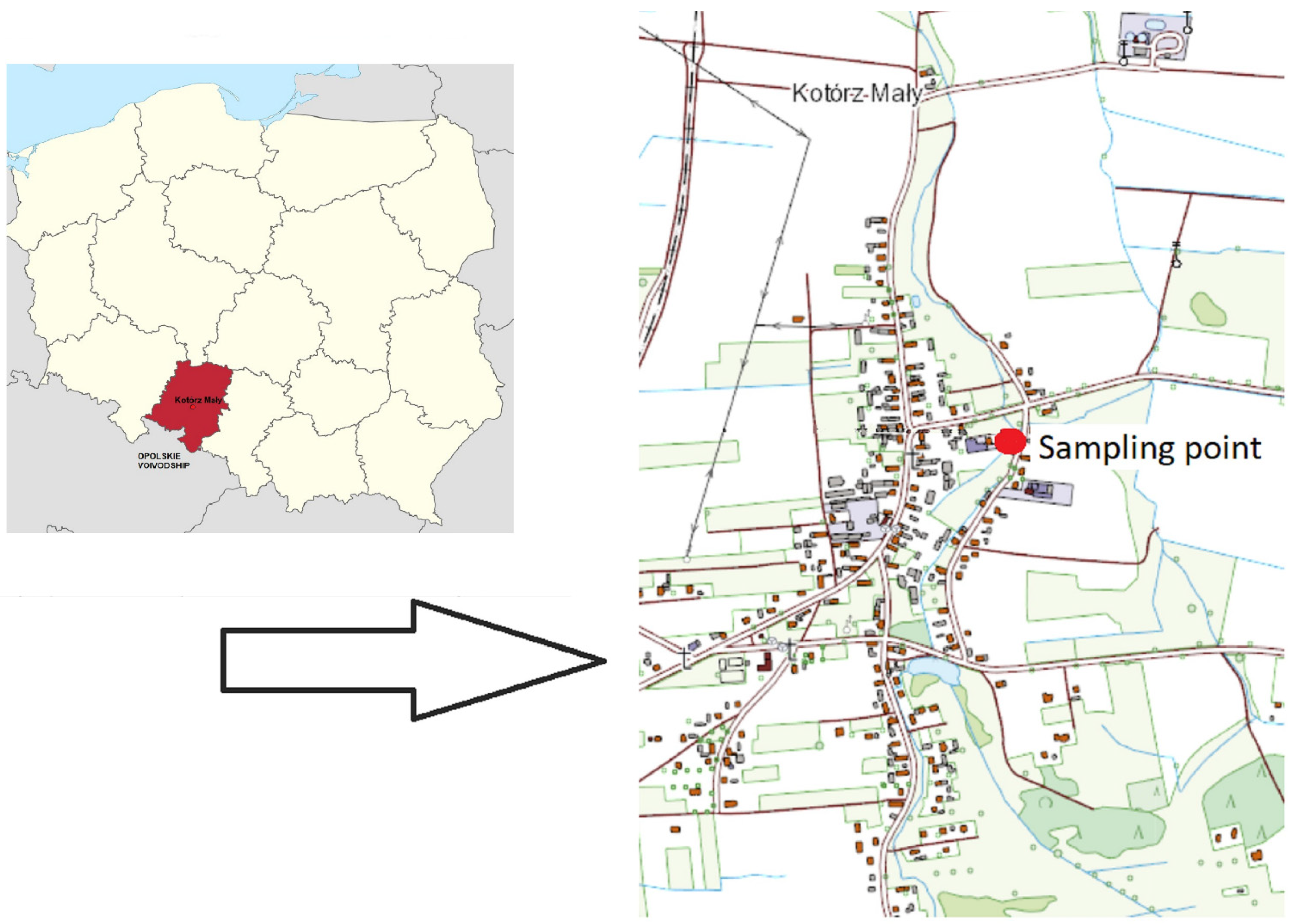
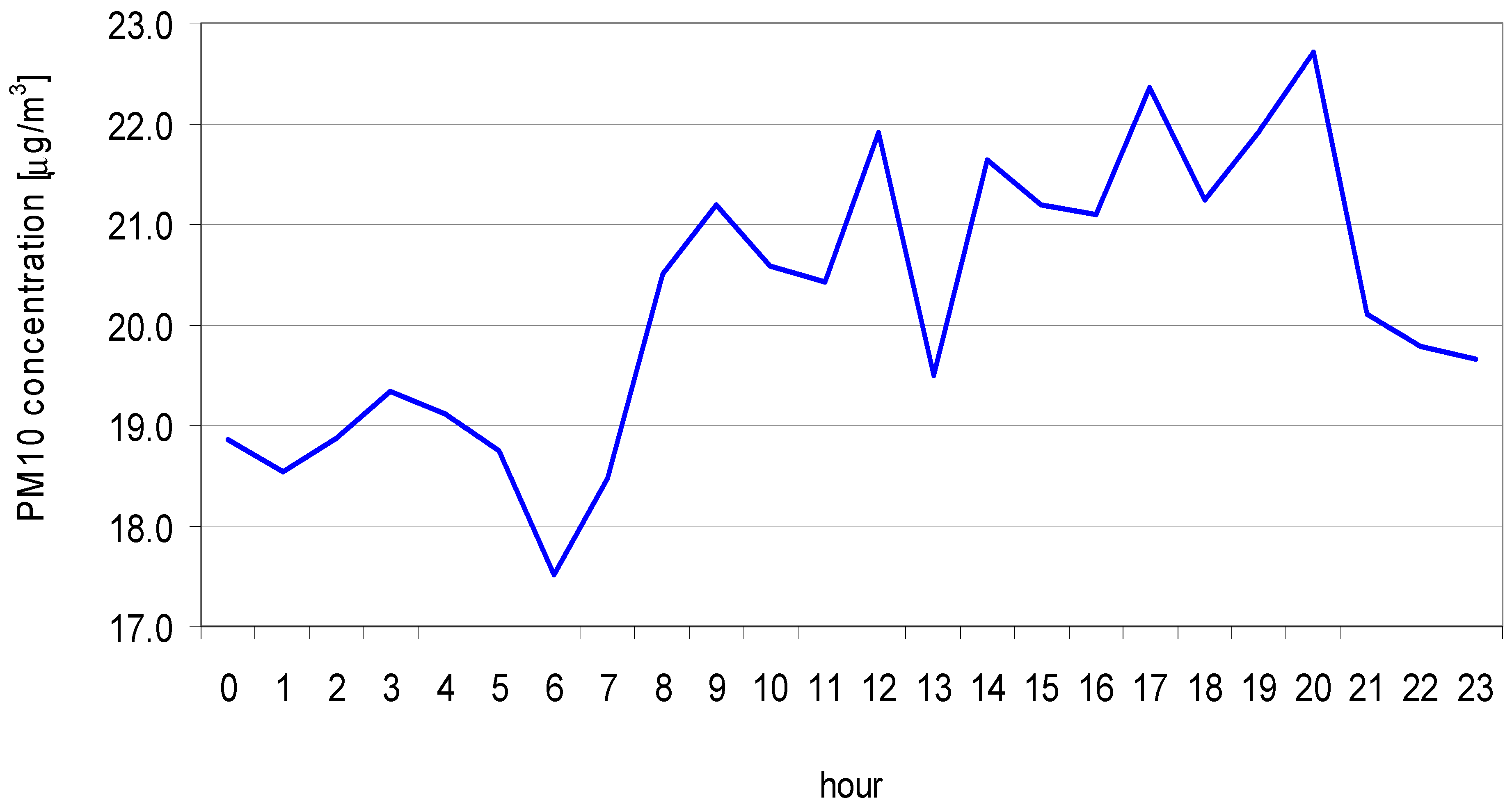
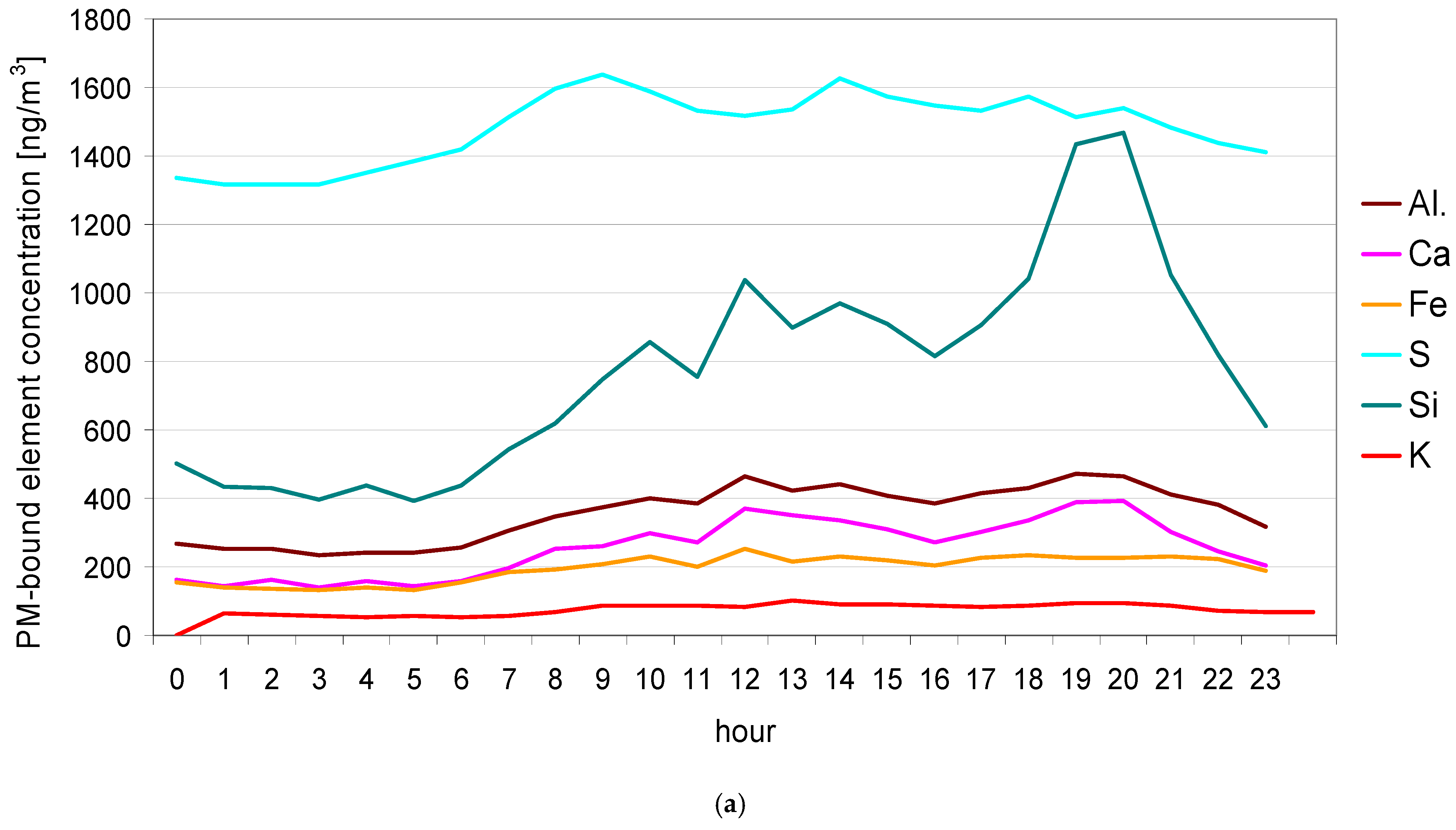
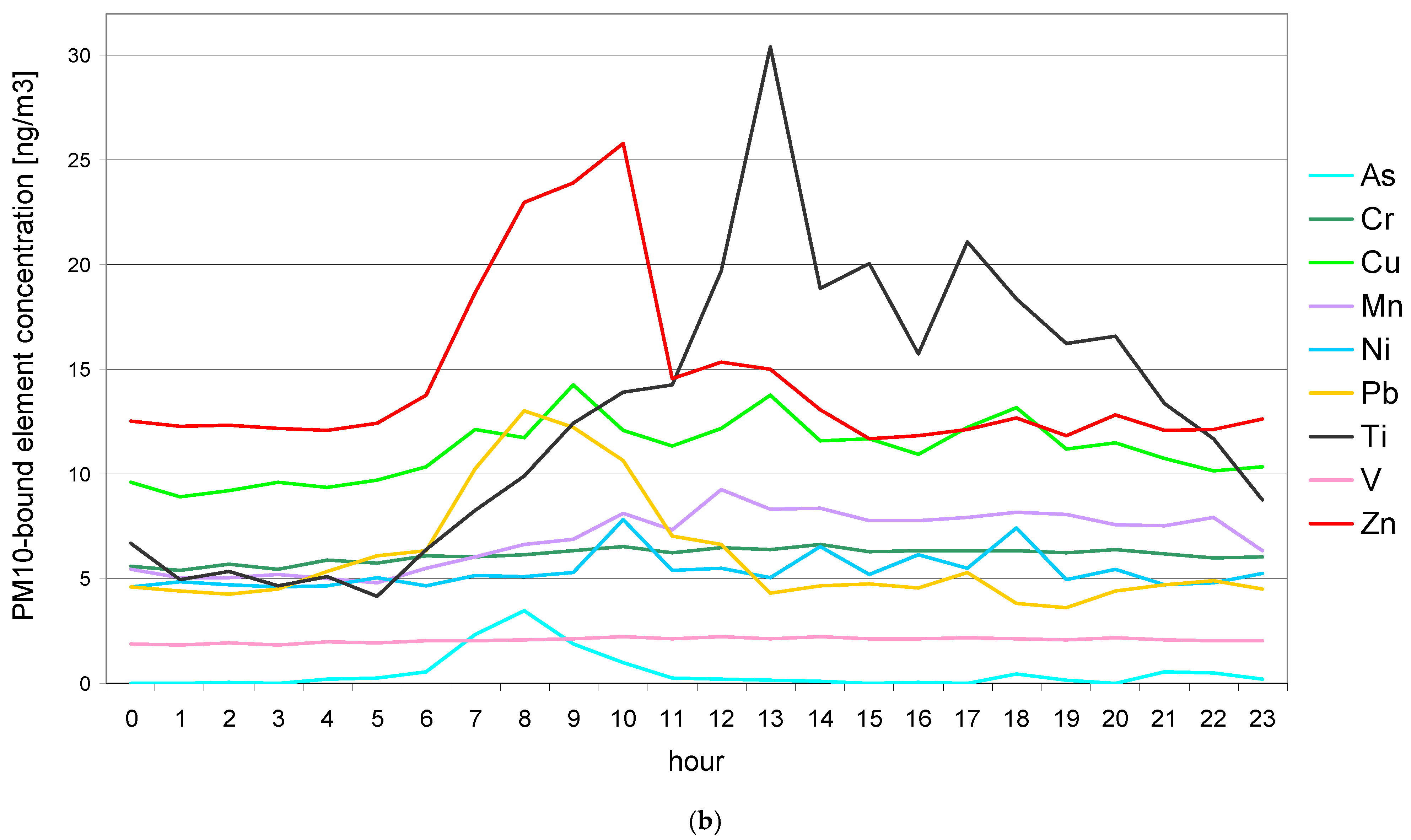
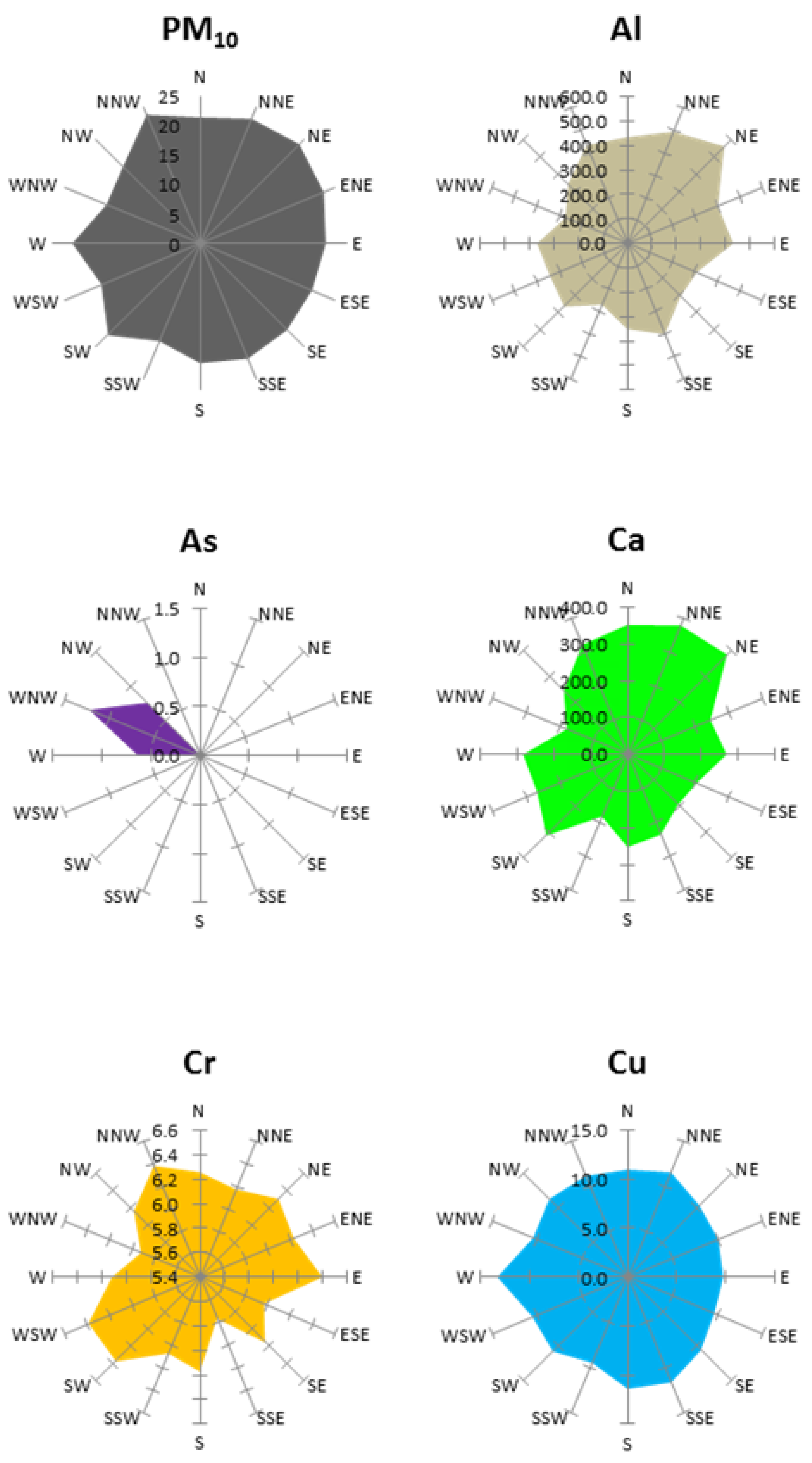

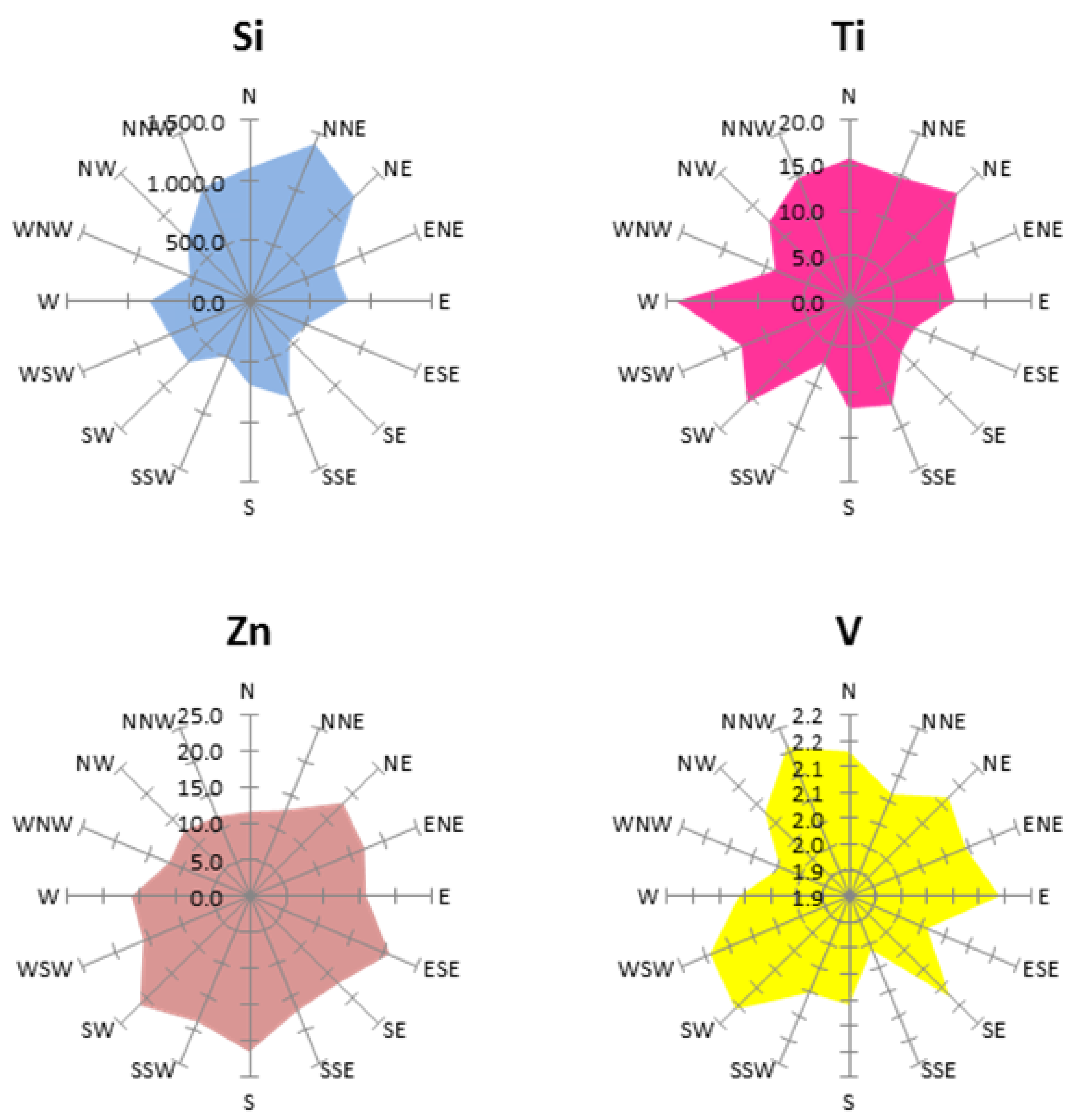

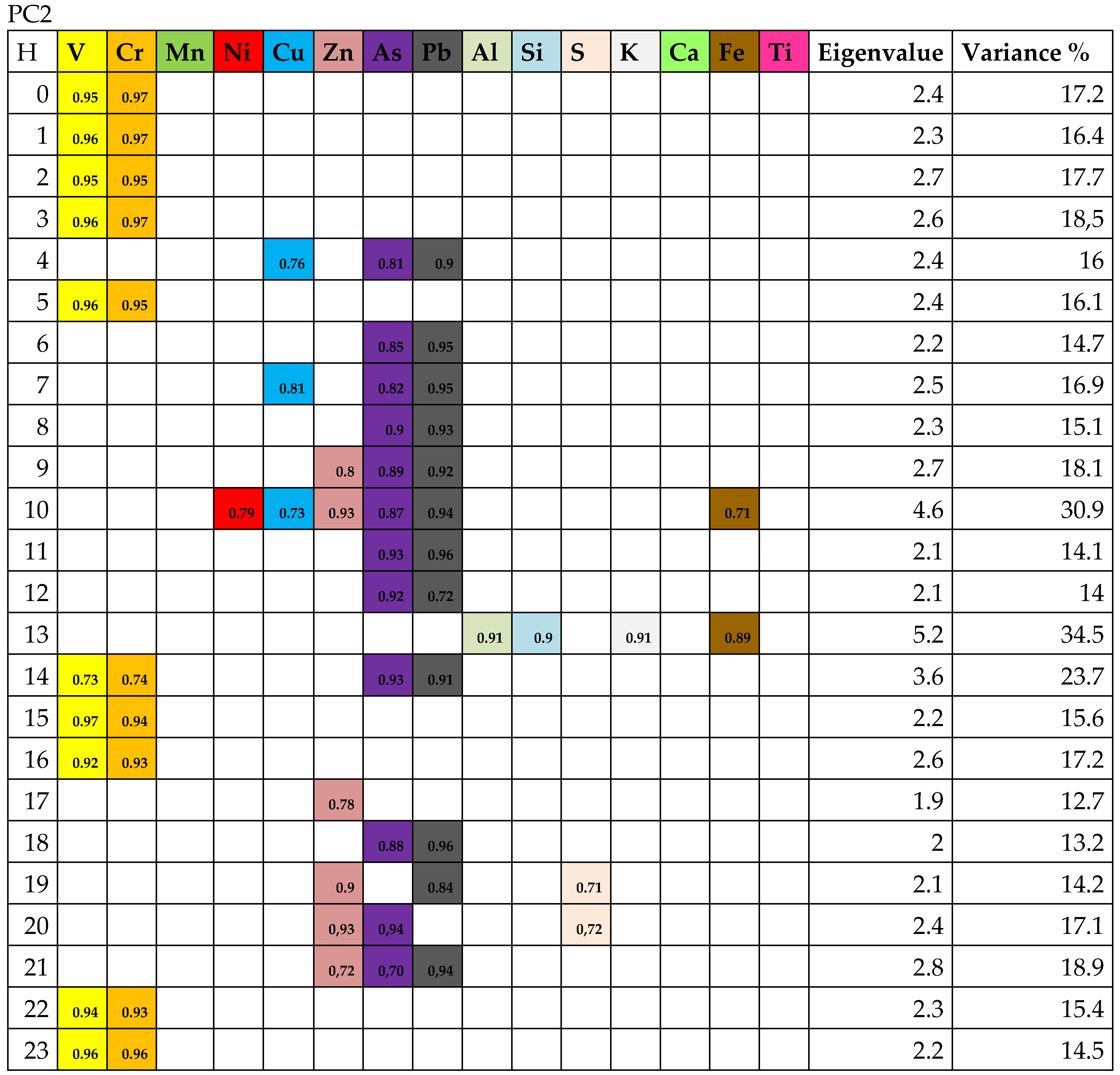
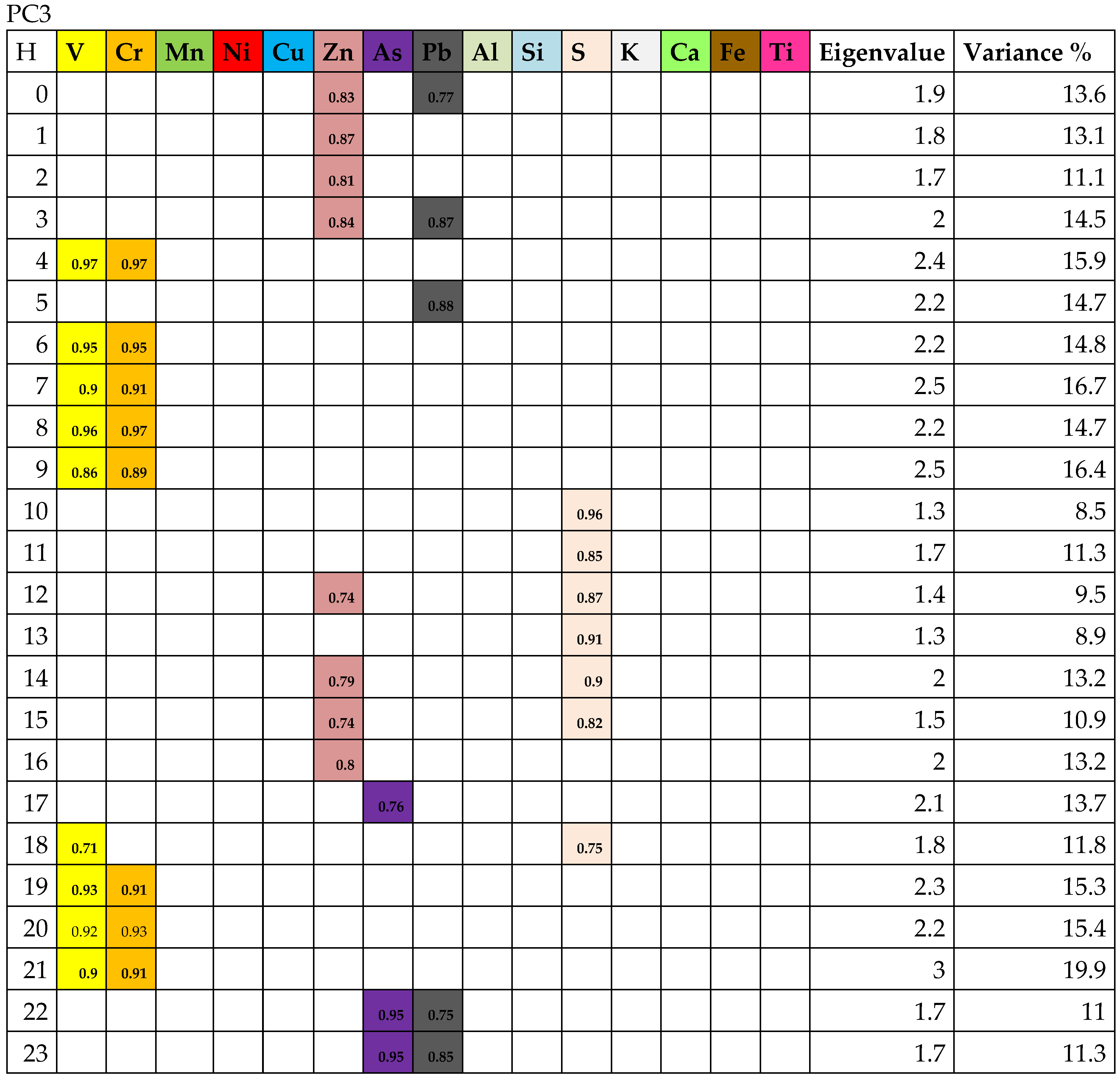
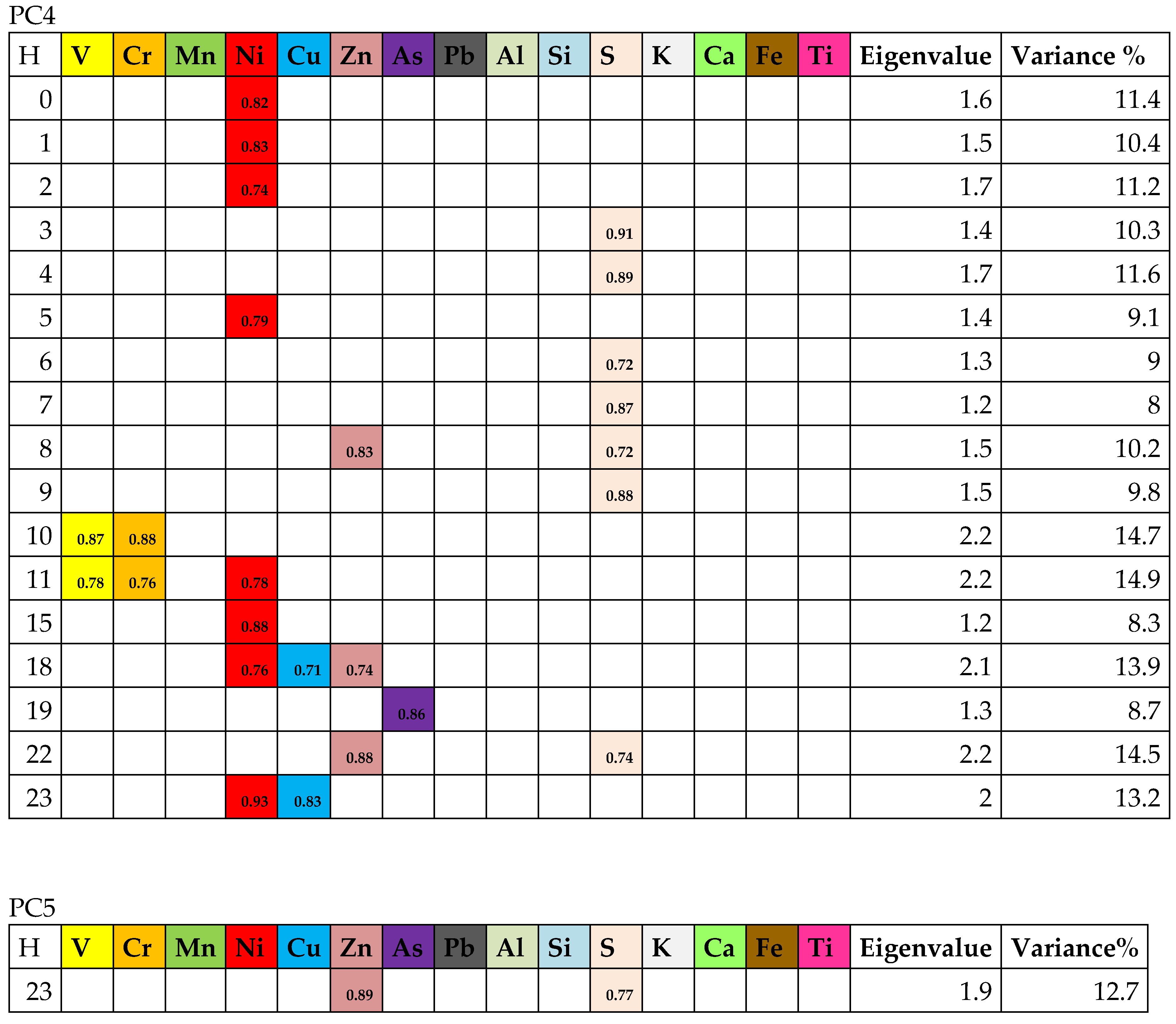
| Parameter | Statistics | ||||
|---|---|---|---|---|---|
| N | Average | Minimum | Maximum | Standard Deviation | |
| PM10, µg/m3 | 29 | 20.8 | 7.1 | 48.4 | 7.5 |
| PM10-bound elements | |||||
| Al, ng/m3 | 29 | 357.2 | 76.4 | 675.0 | 154.9 |
| As, ng/m3 | 29 | 0.5 | <LLD | 4.5 | 1.0 |
| Ca, ng/m3 | 29 | 256.2 | 64.6 | 517.5 | 134.1 |
| Cr, ng/m3 | 29 | 6.1 | 5.2 | 7.3 | 0.5 |
| Cu, ng/m3 | 29 | 11.2 | 7.1 | 22.8 | 3.1 |
| Fe, ng/m3 | 29 | 195.2 | 63.9 | 355.4 | 77.1 |
| K, ng/m3 | 29 | 76.7 | 5.4 | 132.5 | 34.3 |
| Mn, ng/m3 | 29 | 6.9 | 3.0 | 12.7 | 2.5 |
| Ni, ng/m3 | 29 | 5.4 | 4.5 | 8.5 | 0.9 |
| Pb, ng/m3 | 29 | 6.1 | 1.4 | 14.9 | 3.9 |
| S, ng/m3 | 29 | 1485.5 | 556.7 | 2352.4 | 487.4 |
| Si, ng/m3 | 29 | 770.3 | 98.5 | 1722.8 | 455.8 |
| Ti, ng/m3 | 29 | 12.8 | 0.3 | 54.8 | 11.7 |
| V, ng/m3 | 29 | 2.1 | 1.8 | 2.5 | 0.2 |
| Gaseous pollutants | |||||
| SO2, µg/m3 | 29 | 3.4 | 1.8 | 4.9 | 0.9 |
| NO, µg/m3 | 29 | 1.0 | 0.5 | 2.8 | 0.5 |
| NO2, µg/m3 | 29 | 6.2 | 3.1 | 8.2 | 1.3 |
| O3, µg/m3 | 29 | 25.1 | 19.3 | 33.1 | 3.8 |
| CO, µg/m3 | 29 | 0.4 | 0.2 | 0.5 | 0.1 |
| Meteorological parameters | |||||
| Temperature max. °C | 29 | 27.8 | 19.0 | 32.6 | 3.4 |
| Temperature min. °C | 29 | 14.8 | 10.5 | 18.6 | 2.2 |
| Temperature average. °C | 29 | 21.1 | 16.8 | 25.6 | 2.3 |
| Humidity % | 29 | 67.6 | 47.7 | 97.7 | 13.8 |
| Wind speed m/s | 29 | 7.1 | 4.2 | 11.7 | 1.9 |
| Atmospheric pressure, hPa | 29 | 1013.7 | 1008.2 | 1017.4 | 2.4 |
| Precipitation, mm | 29 | 1.7 | 0.0 | 12.0 | 3.6 |
| Sampling Site (City, Type) | Measurement Period | PM10 (µg/m3) | Concentration (ng/m3) | |||||||||||
|---|---|---|---|---|---|---|---|---|---|---|---|---|---|---|
| As | Ca | Cr | Cu | Fe | K | Mn | Ni | Pb | Ti | V | Zn | |||
| Kotórz Mały, this study | Summer 2018 | 21 | 0.5 | 256.2 | 6.1 | 11.2 | 195.2 | 76.7 | 6.9 | 5.4 | 6.1 | 12.8 | 2.1 | 14.5 |
| Warsaw, urban area [53] | Summer 2017 | 40 | 228.9 | 52.5 | 16.2 | 145.9 | 21.4 | 10.8 | 17.2 | |||||
| Wadowice, urban area [54] | Winter 2017 | 174 | 11.0 | 590.0 | 4.0 | 27.0 | 760.0 | 1400.0 | 27.0 | 4.2 | 120.0 | 56.0 | 15.0 | 360.0 |
| Poznań, urban area [35] | Summer 2017 | 17 | 2611.0 | 48.0 | ||||||||||
| Wrocław, urban area [35] | Summer 2016 | 17 | 1080.0 | 300.0 | ||||||||||
| Poznań, urban area [55] | 2010–2016 | 17 | 1.0 | 1.2 | ||||||||||
| Upper Silesia, rural area [56] | Spring 2014 | 23 | 0.8 | 239.4 | 2.5 | 217.3 | 12.3 | 6.2 | 20.4 | 72.7 | ||||
| Kraków, urban area [57] | Winter 2015 | 30–95 | 580.0 | 10.1 | 23.6 | 160.0 | 22.5 | 3.2 | 45.7 | 73.5 | 3.9 | 148.6 | ||
| Period | Element | ||||||||||||||
|---|---|---|---|---|---|---|---|---|---|---|---|---|---|---|---|
| Al | As | Ca | Cr | Cu | Fe | K | Mn | Ni | Pb | S | Si | Ti | V | Zn | |
| 0 | 2.1 | 0.0 | 3.3 | 97.3 | 406.8 | 3.1 | 1.3 | 6.2 | 150.3 | 164.2 | 849.0 | 1.0 | 1.3 | 21.6 | 146.3 |
| n1 | 2.3 | 0.0 | 3.4 | 108.2 | 437.1 | 3.2 | 1.5 | 6.7 | 182.4 | 181.3 | 969.3 | 1.0 | 1.1 | 24.1 | 165.6 |
| 2 | 2.3 | 24.2 | 3.9 | 114.5 | 454.3 | 3.1 | 1.4 | 6.8 | 179.2 | 176.1 | 976.8 | 1.0 | 1.2 | 25.6 | 167.3 |
| 3 | 2.3 | 0.0 | 3.6 | 119.1 | 515.5 | 3.3 | 1.4 | 7.5 | 189.4 | 203.7 | 1057.8 | 1.0 | 1.1 | 26.4 | 179.2 |
| 4 | 2.2 | 64.2 | 3.7 | 116.8 | 454.3 | 3.2 | 1.4 | 6.6 | 174.2 | 217.7 | 985.9 | 1.0 | 1.1 | 26.0 | 161.2 |
| 5 | 2.4 | 92.0 | 3.7 | 127.1 | 526.0 | 3.4 | 1.4 | 7.1 | 210.9 | 278.5 | 1128.0 | 1.0 | 1.0 | 28.6 | 185.1 |
| 6 | 2.3 | 195.7 | 3.8 | 120.2 | 500.3 | 3.4 | 1.4 | 7.2 | 174.0 | 258.4 | 1029.0 | 1.0 | 1.4 | 26.8 | 183.5 |
| 7 | 2.2 | 655.8 | 3.7 | 97.0 | 474.9 | 3.3 | 1.4 | 6.4 | 155.0 | 337.2 | 889.0 | 1.0 | 1.5 | 21.4 | 201.2 |
| 8 | 2.2 | 855.5 | 4.2 | 86.3 | 403.1 | 3.1 | 1.5 | 6.2 | 134.6 | 376.5 | 821.5 | 1.0 | 1.6 | 19.1 | 216.8 |
| 9 | 2.0 | 382.2 | 3.6 | 73.7 | 406.2 | 2.7 | 1.2 | 5.3 | 115.4 | 292.6 | 699.0 | 1.0 | 1.6 | 16.4 | 187.0 |
| 10 | 1.8 | 179.0 | 3.6 | 65.9 | 299.1 | 2.7 | 1.1 | 5.4 | 148.9 | 221.3 | 590.0 | 1.0 | 1.6 | 14.7 | 175.6 |
| 11 | 2.0 | 46.3 | 3.7 | 71.7 | 318.6 | 2.6 | 1.2 | 5.6 | 116.5 | 166.7 | 646.1 | 1.0 | 1.8 | 16.0 | 112.8 |
| 12 | 1.8 | 26.9 | 3.7 | 54.4 | 248.6 | 2.4 | 1.1 | 5.1 | 86.3 | 114.0 | 465.7 | 1.0 | 1.8 | 12.2 | 86.5 |
| 13 | 1.8 | 24.6 | 4.0 | 61.7 | 326.5 | 2.4 | 1.1 | 5.4 | 92.0 | 85.9 | 545.7 | 1.0 | 3.3 | 13.6 | 97.8 |
| 14 | 1.8 | 17.8 | 3.6 | 59.2 | 253.5 | 2.3 | 1.0 | 5.0 | 109.6 | 85.3 | 534.2 | 1.0 | 1.9 | 13.2 | 78.5 |
| 15 | 1.8 | 0.0 | 3.5 | 60.0 | 272.3 | 2.4 | 1.0 | 4.9 | 93.5 | 93.7 | 550.3 | 1.0 | 2.1 | 13.3 | 74.8 |
| 16 | 1.9 | 11.7 | 3.4 | 67.5 | 284.3 | 2.5 | 1.1 | 5.5 | 123.3 | 100.2 | 603.2 | 1.0 | 1.9 | 14.9 | 84.8 |
| 17 | 1.8 | 3.3 | 3.4 | 60.7 | 286.4 | 2.4 | 1.0 | 5.0 | 99.4 | 104.7 | 539.3 | 1.0 | 2.3 | 13.7 | 78.3 |
| 18 | 1.6 | 67.6 | 3.3 | 52.7 | 268.7 | 2.2 | 0.9 | 4.5 | 116.2 | 65.3 | 480.5 | 1.0 | 1.7 | 11.8 | 71.0 |
| 19 | 1.3 | 16.5 | 2.8 | 37.7 | 165.8 | 1.5 | 0.7 | 3.2 | 56.6 | 45.2 | 335.9 | 1.0 | 1.1 | 8.3 | 48.1 |
| 20 | 1.2 | 0.0 | 2.7 | 37.8 | 166.6 | 1.5 | 0.6 | 3.0 | 60.5 | 53.9 | 334.2 | 1.0 | 1.1 | 8.4 | 51.0 |
| 21 | 1.5 | 79.7 | 3.0 | 50.9 | 216.7 | 2.2 | 0.7 | 4.1 | 72.6 | 79.9 | 448.1 | 1.0 | 1.2 | 11.4 | 66.9 |
| 22 | 1.8 | 91.1 | 3.1 | 63.3 | 263.2 | 2.7 | 0.9 | 5.6 | 95.5 | 107.3 | 558.3 | 1.0 | 1.4 | 14.1 | 86.3 |
| 23 | 2.0 | 50.6 | 3.5 | 85.8 | 359.7 | 3.1 | 1.2 | 6.0 | 140.6 | 131.5 | 738.2 | 1.0 | 1.4 | 19.3 | 120.7 |
| 3–31.07 (average) | 1.8 | 98.5 | 3.4 | 68.7 | 308.6 | 2.5 | 1.1 | 5.2 | 114.4 | 141.4 | 614.1 | 1.0 | 1.6 | 15.6 | 109.9 |
Publisher’s Note: MDPI stays neutral with regard to jurisdictional claims in published maps and institutional affiliations. |
© 2021 by the authors. Licensee MDPI, Basel, Switzerland. This article is an open access article distributed under the terms and conditions of the Creative Commons Attribution (CC BY) license (https://creativecommons.org/licenses/by/4.0/).
Share and Cite
Mach, T.; Rogula-Kozłowska, W.; Bralewska, K.; Majewski, G.; Rogula-Kopiec, P.; Rybak, J. Impact of Municipal, Road Traffic, and Natural Sources on PM10: The Hourly Variability at a Rural Site in Poland. Energies 2021, 14, 2654. https://doi.org/10.3390/en14092654
Mach T, Rogula-Kozłowska W, Bralewska K, Majewski G, Rogula-Kopiec P, Rybak J. Impact of Municipal, Road Traffic, and Natural Sources on PM10: The Hourly Variability at a Rural Site in Poland. Energies. 2021; 14(9):2654. https://doi.org/10.3390/en14092654
Chicago/Turabian StyleMach, Tomasz, Wioletta Rogula-Kozłowska, Karolina Bralewska, Grzegorz Majewski, Patrycja Rogula-Kopiec, and Justyna Rybak. 2021. "Impact of Municipal, Road Traffic, and Natural Sources on PM10: The Hourly Variability at a Rural Site in Poland" Energies 14, no. 9: 2654. https://doi.org/10.3390/en14092654
APA StyleMach, T., Rogula-Kozłowska, W., Bralewska, K., Majewski, G., Rogula-Kopiec, P., & Rybak, J. (2021). Impact of Municipal, Road Traffic, and Natural Sources on PM10: The Hourly Variability at a Rural Site in Poland. Energies, 14(9), 2654. https://doi.org/10.3390/en14092654








